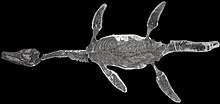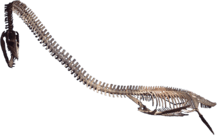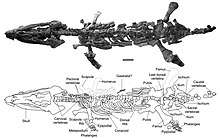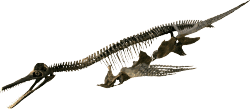Microcleididae
Microcleididae is an extinct family of basal plesiosauroid plesiosaurs from the Early Jurassic (middle Sinemurian to late Toarcian stages) of France, Germany, Portugal and the United Kingdom. Currently, the oldest and the most known microcleidid is Eretmosaurus from the middle Sinemurian of the United Kingdom. Microcleididae was formally named and described by Roger B. J. Benson, Mark Evans and Patrick S. Druckenmiller in 2012.[1][2]
| Microcleidids | |
|---|---|
 | |
| Microcleidus homalospondylus skeleton | |
| Scientific classification | |
| Kingdom: | Animalia |
| Phylum: | Chordata |
| Class: | Reptilia |
| Superorder: | †Sauropterygia |
| Order: | †Plesiosauria |
| Superfamily: | †Plesiosauroidea |
| Family: | †Microcleididae Benson, Evans & Druckenmiller, 2012 |
| Genera | |
History and Phylogeny
Großman (2007) referred informally to "microcleidid elasmosaurs", a clade comprising the three taxa referred to the Microcleididae by Benson et al. (2012). Ketchum and Benson (2010) found the traditional "microcleidid" genera to nest within a monophyletic Plesiosauridae, in a close position to Plesiosaurus.[3] However, Ketchum and Benson (2011) performed a phylogenetic analysis which found a monospecific Plesiosauridae, and a monophyletic Microcleididae.[4] Smith et al. (in press) described a new "microcleidid" Lusonectes, and obtained similar results in a different phylogenetic analysis.[2] However, the family has not formally been erected until Benson et al. (2012) also found the same results in their analysis.[1]

To avoid further confusion between Plesiosauridae and Microcleididae, Benson et al. (2012) proposed a stem-based definition for this taxon, utilizing Plesiosaurus as an external specifier. Microcleididae was defined as "Microcleidus homalospondylus and all taxa more closely related to it than to Plesiosaurus dolichodeirus, Cryptoclidus eurymerus, Elasmosaurus platyurus, Leptocleidus superstes, Pliosaurus brachydeirus or Polycotylus latipinnis." Benson et al. (2012) found strong support for Microcleididae, however they diagnosis focused on unambiguous postcranial synapomorphies since cranial material of basal microcleidids is unknown. The synapomorphies are: widely separated posterior cervical rib facets, posteriormost dorsal rib facets split between centrum and neural arch, medial surface of the iliac blade anteroposteriorly concave and a prominent flange extends anteriorly from the proximal half of the radius. This analysis focused on basal plesiosaurs and therefore only one derived pliosaurid and one cryptoclidian were included while elasmosaurids weren't included at all. The cladogram below follows the topology from Benson et al. (2012) analysis.[1]
| Plesiosauria |
| |||||||||||||||||||||||||||||||||||||||||||||||||||||||||||||||
References
- Roger B. J. Benson, Mark Evans and Patrick S. Druckenmiller (2012). "High Diversity, Low Disparity and Small Body Size in Plesiosaurs (Reptilia, Sauropterygia) from the Triassic–Jurassic Boundary". PLoS ONE. 7 (3): e31838. doi:10.1371/journal.pone.0031838. PMC 3306369. PMID 22438869.CS1 maint: uses authors parameter (link)
- Adam S. Smith, Ricardo Araújo and Octávio Mateus (2011). "Lusonectes sauvagei, a new plesiosauroid from the Toarcian (Lower Jurassic) of Alhadas, Portugal" (PDF). Acta Palaeontologica Polonica. in press. doi:10.4202/app.2011.0023.CS1 maint: uses authors parameter (link)
- Ketchum, H.F.; Benson, R.B.J. (2010). "Global interrelationships of Plesiosauria (Reptilia, Sauropterygia) and the pivotal role of taxon sampling in determining the outcome of phylogenetic analyses". Biological Reviews of the Cambridge Philosophical Society. 85 (2): 361–392. doi:10.1111/j.1469-185X.2009.00107.x. PMID 20002391.
- Hilary F. Ketchum and Roger B. J. Benson (2011). "A new pliosaurid (Sauropterygia, Plesiosauria) from the Oxford Clay Formation (Middle Jurassic, Callovian) of England: evidence for a gracile, longirostrine grade of Early-Middle Jurassic pliosaurids". Special Papers in Palaeontology. 86: 109–129. doi:10.1111/j.1475-4983.2011.01083.x.CS1 maint: uses authors parameter (link)




